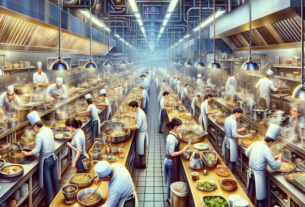The Impact of Data Analytics on Restaurant Strategies
In recent years, data analytics has revolutionized the way restaurants operate and make strategic decisions. By leveraging data from various sources such as point-of-sale systems, customer feedback, and social media, restaurants can gain valuable insights into consumer behavior, preferences, and trends. This information helps them make informed decisions on menu offerings, pricing, marketing strategies, and operational efficiency.
Financial Benefits of Data Analytics in Restaurants
One of the key benefits of data analytics for restaurants is the ability to optimize pricing and menu offerings. By analyzing sales data and customer preferences, restaurants can identify which items are most popular and profitable, and adjust pricing accordingly. For example, a restaurant may discover that certain menu items have a higher profit margin and can be priced slightly higher without impacting sales volume. This can lead to increased revenue and profitability for the restaurant.
Moreover, data analytics can also help restaurants reduce costs and improve operational efficiency. By analyzing data on food waste, inventory levels, and employee productivity, restaurants can identify areas where costs can be reduced and efficiency can be improved. For instance, a restaurant may discover that a certain ingredient is frequently wasted and can adjust their ordering practices to reduce waste and save money.
Market Share and Competitive Advantage
Restaurants that effectively utilize data analytics have a competitive advantage in the market. By understanding consumer preferences and trends, restaurants can tailor their menu offerings and marketing strategies to better meet the needs of their target audience. This can help them attract and retain customers, ultimately leading to increased market share and profitability.
For example, a restaurant may use data analytics to identify a growing trend in plant-based dining and introduce a new plant-based menu to cater to this demand. By being proactive and responsive to consumer preferences, the restaurant can differentiate itself from competitors and attract a new segment of customers.
Volume and Customer Loyalty
Data analytics can also help restaurants improve customer loyalty and retention. By analyzing customer feedback and behavior, restaurants can identify areas where they can improve the customer experience and build stronger relationships with their customers. For instance, a restaurant may use data analytics to track customer satisfaction scores and identify trends in customer complaints. By addressing these issues proactively, the restaurant can improve customer satisfaction and loyalty.
Furthermore, data analytics can help restaurants personalize the customer experience and create targeted marketing campaigns. By analyzing customer data such as previous orders, preferences, and demographics, restaurants can tailor marketing messages and promotions to individual customers. This personalized approach can help restaurants build stronger relationships with customers and increase repeat business.
Future Plans and Innovations in Data Analytics for Restaurants
As data analytics continues to evolve, restaurants are exploring new ways to leverage data to drive business growth and innovation. Some of the future plans and innovations in data analytics for restaurants include:
Predictive Analytics
Predictive analytics is becoming increasingly popular in the restaurant industry, allowing restaurants to forecast trends and make proactive decisions. By analyzing historical data and using algorithms to predict future outcomes, restaurants can anticipate customer demand, optimize inventory levels, and improve operational efficiency. For example, a restaurant may use predictive analytics to forecast which menu items will be most popular on a given day and adjust their staffing and inventory levels accordingly.
Artificial Intelligence and Machine Learning
Artificial intelligence (AI) and machine learning are also playing a significant role in data analytics for restaurants. These technologies can analyze large volumes of data quickly and efficiently, uncovering insights that would be difficult or impossible for humans to identify. For example, AI-powered algorithms can analyze customer reviews and social media data to identify trends and sentiment around a restaurant’s brand, helping them make strategic decisions on marketing and customer service.
Integration with Internet of Things (IoT) Devices
The Internet of Things (IoT) is another area of innovation in data analytics for restaurants. By connecting various devices such as smart kitchen appliances, inventory sensors, and customer feedback terminals, restaurants can collect real-time data on operations and customer interactions. This data can be analyzed to improve efficiency, reduce waste, and enhance the customer experience. For example, a restaurant may use IoT devices to monitor food temperatures in real-time and ensure food safety compliance.
Conclusion
In conclusion, data analytics is transforming the restaurant industry by providing valuable insights into consumer behavior, preferences, and trends. Restaurants that effectively leverage data analytics can optimize pricing, menu offerings, and operational efficiency, leading to increased revenue and profitability. Moreover, data analytics can help restaurants gain a competitive advantage in the market, improve customer loyalty, and drive innovation. As data analytics continues to evolve, restaurants are exploring new technologies and strategies to further enhance their business operations and deliver exceptional customer experiences.



